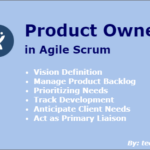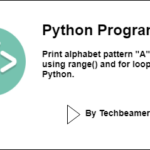We’ve again come up with more Agile Scrum Questions for interview preparation for Scrum masters and software engineers. Most of these questions are based on our reader’s feedback from their own experience.
Agile Scrum Questions for Interview Preparation
Find out the top Agile Scrum Questions and practice to the end for sure success.
Q-1. Why do we use the Fibonacci series in Scrum?
Ans.
The idea for using the Fibonacci sequence is, to reflect the uncertainty in estimating big items.
It means that when we assign a low value of points to a task, we are more confident of the context, difficulties, and attributes of that task.
However, a high estimate indicates that the story requires breaking down further into smaller tasks.
Q-2. What do you understand by the Definition of Done (DoD) in Agile?
Ans.
The definition of Done (DoD) enables us to determine when a task from the backlog is getting completed. It is a comprehensive checklist of activities to ensure the quality and completeness of features delivered.
The DoD could be different from one Scrum Team to another, but it is essential to be unique for teams working on the same product.
Q-3. What is the definition of Acceptance Criteria?
Ans.
Acceptance Criteria are the requirements that a software product must satisfy so that the end user, customer, or other stakeholders affirm its acceptability.
In other words, Acceptance Criteria outlines the parameters and limits of a User Story, based on which the team can conclude that it has completed and is working as expected.
Q-4. Who devises the Definition of Done?
Ans.
The Scrum team (Dev team, Scrum Master, and Product Owner together) creates the Definition of Done while the PO formulates Acceptance Criteria.
Even though these concepts are orthogonal, both of them are mandatory to mark a User Story as complete.
Q-5. What is the purpose of the Iteration review?
Ans.
The Iteration review provides a channel to collect critical, contextual feedback. Its purpose is to review the progress by presenting the working user stories to the product owner and other stakeholders.
The Iteration review serves three main functions.
- It indicates the closure of the iteration timebox. The whole team has contributed to its success which will add value to the business.
- Provides an opportunity for the team to showcase the contributions they have made to the business and in turn, take some satisfaction and pride by looking at their work and progress.
- Enables the Stakeholders to examine the working User Stories and provide feedback to improve the product.
Q-6. What do you understand by Backlog Grooming/Refinement?
Ans.
Product Backlog Grooming also referenced as Product Backlog Refinement, is one of the primary steps in Scrum used for maintaining the Backlog. It is the activity where the Product Owner, along with some or all of the team members review the items listed in the backlog.
The following activities take place during the backlog grooming.
- Update the backlog so that it contains relevant items.
- Set the priority of the items present.
- Stock more details on the items so that the team can get more clarity on the requirements.
Backlog grooming is a collaborative discussion process that starts at the end of one sprint. It ensures that backlog items are in a ready-to-pull state.
Q-7. How do you choose to refine items from the Product Backlog?
Ans.
Sooner or later, all product backlog items go through the refining process. However, some with a higher priority might get moved to the immediate next sprint.
Refining ensures that enough information is available so that the team can split them into subtasks. With a better understanding, it is easy to create a release plan and commit to its delivery.
Q-8. What is the benefit of having Product Backlog refinement sessions?
Ans.
Product Backlog refinement session adds value in so many ways.
- It ensures that the team starts reviewing and revising the contents of high-priority items from the backlog.
- Any team member can raise queries on the scope and get it resolved at an early stage.
- It supports the team to understand the Product Backlog requirements more clearly. They become good at estimation. It may close some of the unknowns in the early phases.
- The refinement session takes place before the Sprint Planning and could also reduce its duration by allowing the team to review and rectify its doubts about the backlog items beforehand.
- In this session, the team may work to derive the Tasks associated with the items listed in the Product Backlog.
- As the activity of refinement progresses, the team identifies the Product Backlog items that do not add value to the upcoming Sprint and can be either deprioritized or excluded.
Q-9. What are the responsibilities of a Product Owner?
Ans.
The Product Owner is among the key stakeholders of the project. He has the following primary responsibilities.
- Creating vision definition
- Managing the product backlog
- Prioritizing needs
- Overseeing development progress
- Anticipating client needs
- Operating as the primary liaison
Check out – Product Manager Role and Responsibilities
Q-10. What does the term ‘chickens’ and ‘pigs’ signify in Scrum?
Ans.
‘Pigs’ and ‘chickens’ are slang terms that Agile Scrum teams use frequently. They represent the different participants in the daily scrum meeting. Scrum has borrowed them from a fable.
The ‘pigs’ are the committed people who have stakes in the project. Their viewpoint is crucial for the success or failure of the project. However, the chickens are the ones who have no direct involvement. They attend the meetings to get an update on the progress.
Thus we can say that chickens are the people who have something to say but usually have nothing to contribute.
Q-11. What is Kanban?
Ans.
Kanban is one of the popular frameworks used to implement Agile. In Kanban, the team organizes their work on a Kanban board, which helps them visualize their progress more efficiently.
The Kanban board allows the team to put all work items of the project in a single place. It lets everyone see a clear picture of the actual progress or the bottlenecks if any, in short, the complete status of the project.
Q-12. How does Kanban work?
Ans.
Kanban works by creating a visualization of the workflow for tracking work items. It defines states and requires all tasks to go through a flow so that it is easy to visualize the progress.
The states appear on the Kanban dashboard in different columns. Usually, they are defined as follows:
- To Do: These are tasks that are yet to start. We can count them as in our backlog.
- Doing: This column gets to have tasks that are in progress.
- Done: All tasks finally reach the done state.
With so much clarity and visualization, Kanban guarantees transparency and identifies bottlenecks beforehand.
Q-13. What does the velocity chart indicate?
Ans.
Velocity charts are a simple yet useful tool that measures the pace at which a team completes its. There are many types of velocity charts, and all of them hold the same objective, to estimate the amount of work the team can accomplish in a given iteration. The frequency of collection varies with the type of velocity chart the team is using.
Q-14. Who is responsible for removing impediments in Scrum?
Ans.
It is one of the prime responsibilities of the Scrum Master to identify, follow, and help the team to remove the impediments. Sometimes, team members remove the blockers on their own after discussing them with the Scrum Master. The Scrum Master may even take support from outside of the team to remove these impediments.
Q-15. Who is responsible for devising the User Stories in an Agile project?
Ans.
We all are aware that it’s the Product Owner’s responsibility to create and maintain a Product Backlog of User Stories for the project. But this does not mean that the Product Owner is the only member who can write a User Story. Anyone from the team can write User Stories. An ideal Agile project anticipates every member of the team to be capable enough to write a good User Story.
Q-16. Can the Product Owner and the Scrum Master be the same person?
Ans.
The simple answer is ‘No.’ The reason is that the role each of them performs in the Scrum team is quite contradictory.
The Scrum Master’s role is to support and protect the Scrum team, whereas the Product Owner has to prioritize the tasks and keep the Backlog ready.
Check out – Product Owner vs. Scrum Master
Q-17. How do you calculate the velocity of an Agile development team?
Ans.
The agile team calculates the Velocity at the end of the Sprint by totaling the Points for all fully completed User Stories. You should not count the Points of incomplete or partially completed User Stories for calculating the velocity.
The velocity of a particular team may vary from one Sprint to another. However, for a growing team, you can expect an upward trend in its value by approximately 10% every Sprint.
Q-18. What is the unit to measure Velocity in Agile?
Ans.
You can measure Velocity with the same unit that you use for feature estimates. It can be story points, days, ideal days, or hours that the Scrum team delivers. All of these units are acceptable to Agile.
Q-19. How will you estimate the Velocity of the first iteration?
Ans.
As per the general guideline, an Agile team should estimate its initial velocity as one-third of the total time available for the iteration. Time allocated to a User Story should also consider the time spent in meetings, design, documentation, research, collaboration, rework, etc.
Let’s say six programmers are working in a sprint of three weeks. It means a total of 90 programmer days (6 programmers x15 days) are available. So a good start would be to allocate 30 days of work in the first iteration. It should include sufficient buffer to account for
- Project overhead
- Estimation inaccuracy if required
If underestimated, velocity will increase after the first iteration as new features will get added. If overestimated, it will decrease as features will be removed.
For the next iteration, the Scrum team should then use the velocity obtained from the first iteration as a reference.
Q-20. How will you estimate the velocity, if the projects team size keeps on changing?
Ans.
For estimating Velocity accurately, it is essential that team size remains consistent. However, if the team size changes, let’s say 20% of the members go on leave, then reduce the planned velocity by 20% approximately. If the unavailable members include some of the pivotal players, like a customer who is less available in the upcoming iteration, then you can reduce the estimate a little more. In one iteration, you can get a better understanding of what the team can deliver and thus their new velocity.
Q-21. How do we measure velocity if the length of the iterations varies?
Ans.
A reliable estimate of the Velocity is attributed to the consistency of the parameters used to calculate it. A fixed-length iteration stimulates a steady rhythm in the project. In the absence of this rhythm, a lot of effort goes in revising, re-estimating, and adjusting in each iteration.
Also, the team may not be able to predict the velocity for future iteration due to the inconsistency of the results. Like other Agile practices, these are just guidelines, and in situations, we have to apply common sense and not just follow these as hardcore rules.
Q-22. What should a team do if the Velocity keeps on fluctuating in successive iterations?
Ans.
Fluctuation in the value of the Velocity is acceptable if it happens within a feasible range. However, if this variation is significant and continues to occur for more than one or two iterations, then it is time for the Scrum team to revisit the estimates and discuss the release plan with the stakeholders.
Q-23. Is it possible to modify the Sprint Backlog during a Sprint?
Ans.
It is unlikely to modify the backlog items during a running Sprint. But if it is utmost necessary, then only the development team has the right to update or remove it from the sprint backlog.
For example, in a condition like a story found to be unimplementable or become redundant because of another feature fulfilling the same requirement or it fell off from the current roadmap due to a management decision.
Summary – Agile Scrum Questions for Interviews
All top IT companies have already adopted the Agile Scrum framework. It has now become essential for every software engineer to learn Agile methodology. Also, it is a must topic in interviews where the interviewer checks your knowledge.
We hope that the above set of Agile Scrum Questions will add sufficient value to your skill set. Anyways, here are some articles that we’ve hand-picked for you. Please go through these and upgrade your knowledge.









